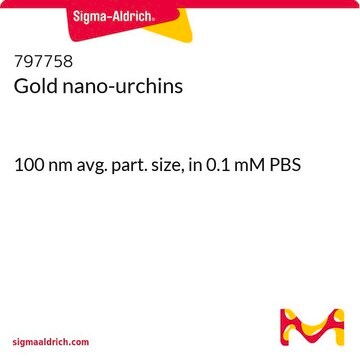742031 is gold nanoparticles in citrate buffer that comes from the external supplier: CytoDiagnostics, Inc Unfortunately, the contents and concentration of components in citrate buffer is proprietary. Hence, there is no citrate buffer product guaranteed to be the same as the stabilized suspension. The vendor's SDS shows the pH of this product is 6-8: https://portal.cytodocs.com/documents/SDS/Stabilized-Gold-Nanoparticles-SDS.pdf
742031
Gold nanoparticles
100 nm diameter, OD 1, stabilized suspension in citrate buffer
Synonym(s):
Au NP, Gold Colloid
About This Item
Recommended Products
Quality Level
form
nanoparticles
suspension
contains
Proprietary Surfactant as stabilizer
concentration
~3.8E+9 particles/mL
OD
1
diameter
100 nm
λmax
565-574 nm
PDI
<0.2
storage temp.
2-8°C
SMILES string
[Au]
InChI
1S/Au
InChI key
PCHJSUWPFVWCPO-UHFFFAOYSA-N
Looking for similar products? Visit Product Comparison Guide
General description
Application
This material is highly monodisperse (<12% variability in size and shape), and provides significantly improved surface reactivity. Applications include Surface Enhanced Raman Lables, Sensing/Detection, Biological Targeting, Plasmonics and Electronics.
Legal Information
Storage Class Code
12 - Non Combustible Liquids
WGK
nwg
Flash Point(F)
Not applicable
Flash Point(C)
Not applicable
Choose from one of the most recent versions:
Already Own This Product?
Find documentation for the products that you have recently purchased in the Document Library.
Customers Also Viewed
-
What are the contents in citrate buffer and the concentration of each of them? Moreover, what is the PH of the citrate buffer? Or do you have any citrate buffer product is same as this stabilized suspension?
1 answer-
Helpful?
-
-
What is the viscosity and the refractive index of its citrate buffer?
1 answer-
Unfortunately, the viscosity and refractive index are not test specifications for this product.
Helpful?
-
-
How to make sure the concentration of the gold nanoparticles (Particles/ml)
1 answer-
The concentration is listed as a test specification on the certificate of analysis. The concentration will be a confirmed result of 3.45E+9-4.22E+9 particles/m
Helpful?
-
-
What is the shape of the gold nanoparticles?
1 answer-
The majority (>95%) of the gold nanoparticles are spherical.
Helpful?
-
-
Which gold nanoparticle size should I choose for my application?
1 answer-
The size of gold nanoparticle to use is very depandent upon the intended application. Generally, smaller particles offer better sensitivity in applications such as immunogold labeling due to less steric hindrance and the ability to bind more gold nanoparticles to the desired target. Small gold nanoparticles are less visible than larger particles, however, which must also be taken into account.As an application example, particles with a size between 30-50nm are particularly useful for the development of rapid tests such as lateral flow assays.
Helpful?
-
-
Do I need to wash my gold nanoparticles?
1 answer-
For most applications, our gold nanoparticles can be used without any additional washing steps. If you have a sensitive application that requires additional washing the best way to do so is by either centrifugation or filtration.
Helpful?
-
-
What is the Department of Transportation shipping information for this product?
1 answer-
Transportation information can be found in Section 14 of the product's (M)SDS.To access the shipping information for this material, use the link on the product detail page for the product.
Helpful?
-
-
Can the Gold nanoparticles be frozen?
1 answer-
No, the Gold nanoparticles should not be frozen. If frozen, the gold nanoparticles will irreversibly aggregate, turning the solution clear.
Helpful?
-
-
How does the storage temperature relate to shipping conditions?
1 answer-
The storage conditions that a Sigma-Aldrich catalog and label recommend for products are deliberately conservative. For many products, long-term storage at low temperatures will increase the time during which they are expected to remain in specification and therefore are labeled accordingly. Where short-term storage, shipping time frame, or exposure to conditions other than those recommended for long-term storage will not affect product quality, Sigma-Aldrich will ship at ambient temperature. The products sensitive to short-term exposure to conditions other than their recommended long-term storage are shipped on wet or dry ice. Ambient temperature shipping helps to control shipping costs for our customers. At any time, our customers can request wet- or dry-ice shipment, but the special handling is at customer expense if our product history indicates that the product is stable for regular shipment.
Helpful?
-
-
How do you attach gold nanoparticles to oligos?
1 answer-
To attach gold nanoparticles to oligos please view the information in the attached reference - Bioconjug Chem. 2011 Apr 20;22(4):794-807. Epub 2011 Mar 28.
Helpful?
-
Active Filters
Our team of scientists has experience in all areas of research including Life Science, Material Science, Chemical Synthesis, Chromatography, Analytical and many others.
Contact Technical Service
